Rash on the larynx. Red rash - what is it? Blood vessel pathologies
A red rash in the throat of a child is a sign of the development of pathological processes in the mucous membrane of the oropharynx. Erythematous rash can be located on the palatine arches, glands, back wall pharynx, soft palate, root of tongue, etc.
The type of disease can be determined by localization of red spots, their size and the accompanying symptomatic picture.
Most often a rash in the throat is a consequence of an infectious lesion of the ciliated epithelium lining the inner surface of the oropharynx.
Provokers inflammatory processes pathogenic viruses, microbes, less often fungi, appear in the ENT organs. In preschool children, itchy red spots in the throat may be due to allergies or diathesis.
The reasons
Why do red spots appear on the mucous membrane of the throat? Rash is rarely a sign of a life-threatening illness. A characteristic small rash on the back of the pharynx in children often indicates an infectious tissue damage. The main causes of stains in the ENT organs include:
- allergic reactions;
- respiratory diseases;
- autoimmune disruptions.
Self-treatment can cause a deterioration in the child's well-being, therefore, when a rash in the throat is detected, you should seek help from a specialist. The doctor will conduct a diagnostic procedure in which he will accurately determine the etiological factors of the problem and the appropriate course of treatment.
As a rule, with the development of infectious diseases, small red dots are localized on the soft palate and the back of the throat. Children can "pour" and because of mechanical damage to the tissues of the throat. Subsequent granulation of the mucous membranes leads to a change in the structure of the ciliated epithelium, as a result of which small bright red patches of connective tissue appear on the surface of the throat, which dissolve with time.
Typical diseases
Red spots in the pharyngeal mucosa occur due to the destruction of tissues. Pathogens that penetrate the ENT organs produce a large number of metabolites that melt healthy cells of the ciliated epithelium. As a result, multiple point hemorrhages are formed on the surface of the throat, i.e. rash.
Most often, rashes in the respiratory tract occur as a result of the development of the following infectious diseases in children:
- herpangina;
- viral pemphigus;
- flu;
- allergy;
- infectious mononucleosis.
Understand what kind of disease was the cause of the rash on the accompanying symptoms. Accurately diagnose pathology can only specialist after conducting appropriate laboratory tests.
Herpangina (Herpangina) - infectionaccompanied by a lesion of pharyngeal formations and a violation of the act of swallowing. Most often the disease is diagnosed in children of preschool age. Echo viruses and Coxsackie are the causative agents of the infection.
Herpangina is one of the highly contagious diseases, the development of which is indicated by the following symptoms:
- red spots in the throat;
- runny nose;
- difficulty swallowing;
- heat (above 40 ° C);
- muscle weakness;
- tickling in the throat.
Small bright red vesicles are localized predominantly on the soft palate, glands, and posterior pharyngeal wall.
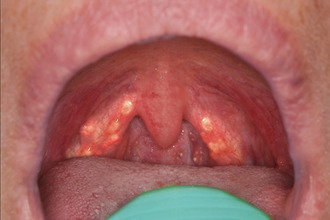 With the progression of the disease, red blotches can increase in diameter, causing the patient painful sensations.
With the progression of the disease, red blotches can increase in diameter, causing the patient painful sensations.
During the treatment of ENT diseases, solid food, which can provoke mechanical damage to the pharyngeal mucous membranes, should be excluded from the patient's diet.
In the event of a bacterial infection, the red blisters fill with pus, resulting in a yellowish rash. At the site of the opening of purulent vesicles, erosive formations occur that can bleed.
Herpes pharyngitis
Herpetic pharyngitis is called inflammation of the mucous membranes of the pharynx, which is accompanied by the formation of red bubbles on the back of the pharynx and palatine arches. The red rash in the airways is caused by the development of the common herpes virus. However, the disease can cause serious complications, therefore, requires adequate and timely treatment.
The development of pathology contributes to local hypothermia of upper respiratory tract organs, reduced body reactivity and aggravation chronic diseases. Typical clinical manifestations of the disease are:
- hyperemia of the mucous membranes of the pharynx;
- itching and burning in the area of inflammation;
- the formation of small vesicles in the throat;
- heat;
- fever;
- salivation;
- pain when swallowing saliva.
Some types of medications prevent tissue regeneration at the site of the opening of the vesicles, which causes scarring.
Young children more often than adults suffer herpetic pharyngitis, which is caused by the low resistance of the child's body, hypovitaminosis and throat injuries. When late treatment of red pustules merge into large bubbles, as a result, they become more painful. It is possible to arrest the further development of pathogenic flora in the ENT organs with the help of antiviral agents and wound healing agents. local action.
Viral pemphigus
Viral pemphigus - a common childhood disease, which is characterized by the formation of large red pustules in the oral cavity and on the skin. Despite the relatively severe course disease, pemphigus does not pose a threat to the patient's life. In case of adequate and timely treatment, the main clinical manifestations of the disease disappear within a week.
The infection is most often caused by enterovirus, which is transmitted by airborne droplets when coughing or sneezing. At the initial stages of the development of pathology, the child feels tired, after which his temperature rises. About a day later, the first symptoms of inflammation of the pharyngeal mucosa appear.
Bubble formations occur not only on the mucous membranes of the oral cavity, but also the skin.
Over time, they burst, resulting in severe pain and discomfort.
Viral pemphigus does not require specific therapy, it passes on its own within 6-7 days. Relieve symptoms of the disease by using antipyretic (Tylenol) and anti-inflammatory (Advil) agents. It should be noted that preschool children should not be given "Aspirin", as it can trigger the development of Reye's syndrome.
Allergic rash
Very often, the cause of red spots in the mucous membrane of the throat is an allergic reaction. Due to increased sensitization of the body, allergy is often manifested in patients under the age of 8 years. In the event of an allergic rash, patients do not complain of itching, scratchy or sore throat.
Provokatory pathological changes in the tissues can 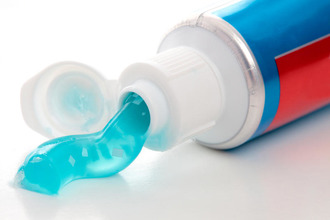 become the following allergens:
become the following allergens:
- citrus;
- chocolate;
- volatile chemicals.
Untimely removal of the stimulus can lead to Quincke edema.
As a rule, an allergic spot does not cause discomfort, but if you do not remove the allergen that provoked an undesirable reaction in time, it can lead to tissue swelling.
In this case, airway obstruction and subsequent hypoxia are not excluded. Eliminate manifestations allergic reaction It is possible with the help of antihistamine drugs, such as Suprasstitn, Zyrtek, Erius, Claritin, etc.
Specific Diseases
In some cases, the red throat may be a manifestation of rare diseases, accompanied by the formation of an atypical rash on the mucous membrane of the oropharynx. If you find characteristic red spots in the throat, you should seek help from a specialist. Self-treatment often leads to "blurring" of the clinical picture, which complicates the correct diagnosis.
The cause of the bright red dots can be:
- kaposi's sarcoma - malignant neoplasms, occurring mainly in patients with immunodeficiency; the development of pathology signals the appearance of purple red spots on the mucous membrane of the oral cavity and pharynx;
- petechiae in the sky - small hemorrhagic vesicles resulting from punctate hemorrhage;
- pyogenic granuloma - red tumor spots on the throat, resulting from the expansion of blood capillaries.
White plaque on vesicles is a consequence of the rejection of dead tissue of the ciliated epithelium. Late treatment of pathologies often becomes the cause of septic inflammation. To prevent the occurrence of complications, it is advisable to seek help from a general practitioner or pediatrician when the first signs of pathology appear.
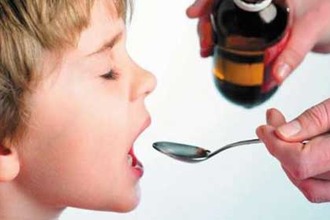 The success of the treatment of red rash on the throat is determined by the correctness of the diagnosis. During the examination, the therapist will assess the nature of the clinical manifestations of the disease and the localization of the rash, and then redirect the patient to an otolaryngologist, an oncologist or an infectious diseases specialist.
The success of the treatment of red rash on the throat is determined by the correctness of the diagnosis. During the examination, the therapist will assess the nature of the clinical manifestations of the disease and the localization of the rash, and then redirect the patient to an otolaryngologist, an oncologist or an infectious diseases specialist.
In most cases, red spots and vesicles result from viral lesions of the respiratory system. Immunostimulating and antiviral drugs will help to eliminate pathogenic flora and manifestations of the disease. The following types of medications are most often included in the treatment of ENT diseases:
- "Acyclovir" is an antiviral drug whose components destroy most of the virions that cause damage to the ciliated epithelium and the skin;
- "Valaciclovir" is an antiviral drug that inhibits the synthesis of the herpes virus DNA, which prevents the development of infection;
- "Viferon" - an interferon inducer of antiproliferative action, increases the activity of immunocompetent cells, which prevents the progression of the disease;
- "Cycloferon" is an antiviral immunostimulant that helps to increase the body's resistance.
Mortar local manifestations of the disease allow solution antiseptics for irrigation of the oropharynx. In pediatric therapy, Faringosept, Hexoral, Orasept, etc. are used to treat the hyperemic mucosa.
Red dots in the throat in adults is a pathological symptom that indicates the presence of malfunctions in the ENT organs. Erythematous rash occurs due to allergic, infectious and endocrine diseases. It can be localized on the walls of the throat, palatine tonsils, root of the tongue, soft palate, etc.
Determine the cause of the pathological symptom can be concomitant clinical manifestations.
The presence of temperature and pain in the localization of lesions often indicate the infectious nature of the origin of the disease.
Only a qualified specialist can accurately determine the causes of erythematous spots on the mucous membrane of the ENT organs after careful examination of the patient.
Red rash in the throat is a clear sign of the development of pathological processes in the mucous membranes of the airways. As a rule, the formation of red spots on the walls of the pharynx extremely rarely indicates the development of serious infectious diseases. The following exogenous and endogenous factors can provoke a rash:
- dry air;
- hypothermia;
- inhalation of volatile chemicals;
- vitamin deficiency;
- reduced body reactivity;
- allergic reactions;
- infectious diseases;
- endocrine disorders;
- malfunctions in the digestive tract;
- bad habits.
Determine the cause of the appearance of erythematous rashes can be at the place of localization of points, their number and associated clinical manifestations.
The most common causes of rashes lie in the development of viral and bacterial infections. But in order to make sure that the suspicions are correct, it is advisable to seek help from a therapist or undergo a hardware examination from an otolaryngologist.
Viral diseases
What can cause red spots in the oropharynx? Theoretically, the cause of the pathological symptom can be any respiratory diseasein which the infection is localized in the throat. Viral diseases are extremely rarely limited to damage to the laryngopharyngeal mucosa, so patients often complain of inflammation of the nasal mucosa and rhinitis.
Among the most common diseases in adults that cause a rash in the throat are:
| Disease | Typical manifestations |
|---|---|
| flu | high fever, chills, headaches, dry mouth, erythematous rashes on the throat, difficulty in nasal breathing, muscle weakness |
| herpangina | febrile fever, vesicular eruptions in the oropharynx, abdominal pain, difficulty swallowing, hypersalivation, fibrous film on the mucous throat |
| herpetic stomatitis | red throat, petechial rashes on the mucous membrane, burning and sore throat, aphthous formations in the mouth, swollen lymph nodes, painful swallowing |
| measles | high temperature, hoarse voice, large red spots on the soft and hard palate, red eye conjunctiva, sneezing and photophobia |
| rubella | macular rash on the body, headaches, inflammation of the throat mucosa, red spots on the palatine arches and the back of the throat, cervical adenopathy |
| infectious mononucleosis | fever, throat inflammation, swollen lymph nodes, pain when swallowing, red oropharyngeal rash, weakness, migraine, high fever |
| pharyngitis virus | perspiration in the laryngopharynx, dry cough, low-grade fever, shortness of breath, small vesicles on the palatine arches and the back of the throat |
It is possible to reliably determine the cause of the erythematous rash only after taking a throat swab for virological and microbiological analysis.
If the mucosa of the hypopharynx is covered with white spots, it is likely that a yeast-like or mold fungus (candidal tonsillitis) has become a provocateur of inflammatory processes in the ENT organs. Late treatment of diseases leads to the spread of infection and damage to the lower parts of the respiratory system, which is fraught with the development of bronchitis, laryngotracheitis, pneumonia, etc.
Bacterial diseases
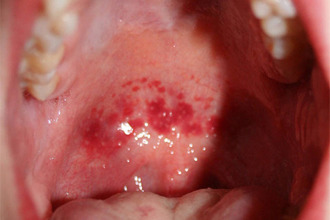 Red rash in the throat in an adult can be a consequence of the development of bacterial infections. As a rule, ENT diseases triggered by the development of microbes cause strong intoxication of the body. Therefore, delayed access to a doctor often becomes the cause of local or even systemic complications.
Red rash in the throat in an adult can be a consequence of the development of bacterial infections. As a rule, ENT diseases triggered by the development of microbes cause strong intoxication of the body. Therefore, delayed access to a doctor often becomes the cause of local or even systemic complications.
In chronic inflammation of the laryngopharyngeal mucosa, the clinical manifestations of the disease are mild, but as a result of poisoning the body with bacterial metabolites, the development of pyelonephritis, glomerulonephritis and cardiovascular insufficiency is not excluded.
Erythematous points and small vesicles in the throat may indicate the development of such pathologies:
| Disease | Typical manifestations |
|---|---|
| angina | pain on swallowing, hyperemia of laryngopharyngeal mucosa, hypertrophy of palatine tonsils, red rash in throat, ulceration of mucous membranes |
| scarlet fever | fever, malaise, petechial rash on the tongue and soft palate, the granularity of the posterior pharyngeal wall, peeling of the skin |
| streptococcal pharyngitis | unproductive cough, tickling in the throat, dry mucosal laryngopharynx, an increase submandibular lymph nodes, fever, erythematous points in the pharynx |
| sinusitis | nasal congestion, headaches, general weakness, sore throat, red spots in the laryngopharyngeal mucosa |
| phlegmonous laryngitis | high fever, increased regional lymph nodes, red vesicles in the throat and larynx, symptoms of intoxication |
Important! Late treatment of bacterial infections leads to the development of abscess and hypoxia.
Active development of bacteria in the lesions leads to the formation of purulent masses in the bubbles on the mucous laryngopharynx. Over time, vesicles filled with clear exudate, replaced by ulcers. If you do not stop inflammation in time, it can lead to the melting of soft tissues and the formation of abscesses.
Rare diseases
Red dots on the back of the throat may be a manifestation of rare, but dangerous diseases. Timely passage drug therapy allows you to prevent the progression of the disease and the development of complications. Solid spots on the soft palate and throat in rare cases indicate the development of pathologies such as:
- kaposi's sarcoma - hemorrhagic rashes on the mucous membranes of the ENT organs, triggered by the development malignant tumors; with the development of pathology often affects the skin and lymph nodes;
- petechiae in the sky - erythematous rash in the throat, which most often occurs against the background of the development of infectious mononucleosis;
- pyogenic granuloma - erythematous dome-shaped nodules formed in the mucous membranes respiratory tract and on the skin; homogeneous red papules are prone to bleeding and dissection, which causes pain and burning.
If the red spot in the throat causes itching or burning, you should be examined by a doctor. In 95% of cases, the rash signals the development of simple diseases that are not life threatening. However, delayed treatment of a banal tonsillitis or pharyngitis can lead to the development of a pharyngeal or peritonsillar abscess, entailing stenosis of the throat and choking.
Allergy
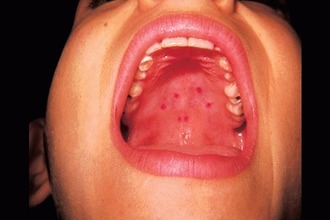 For some reason, can "pour" the throat? In the absence of hyperthermia and symptoms of intoxication, erythematous rash in the throat can signal an allergic reaction. Exogenous and endogenous stimuli can provoke the formation of red spots on the mucous laryngopharynx, such as:
For some reason, can "pour" the throat? In the absence of hyperthermia and symptoms of intoxication, erythematous rash in the throat can signal an allergic reaction. Exogenous and endogenous stimuli can provoke the formation of red spots on the mucous laryngopharynx, such as:
- composite fillings;
- medication;
- toothpastes and rinses;
- food;
- dentures and pins;
- polymer crowns.
Allergy can cause severe edema laryngopharyngeal mucosa and difficulty breathing.
If the larynx is strewn with punctate spots that do not cause discomfort, most likely, the reason for their appearance lies in an allergic reaction. Animal hair, household chemicals and flowering plants are typical allergens that cause irritation of the mucous membrane and, accordingly, the formation of small red dots on the walls of the throat. Alleviate the manifestations of allergy antihistamines systemic and local action. However, the pathological reaction can be completely eliminated only if the provoking factor is eliminated, i.e. allergen.
Other reasons
Rash in the throat, causing severe discomfort and pain, signal a change in the morphology of soft tissues in the localization of red spots. Erythematous spots, localized in the soft palate and tongue, in some cases occur due to the development of complex diseases:
- staphylococcal infection;
- exudative erythema;
- kawasaki syndrome;
- syphilis;
- roseola;
- meningitis.
Since the list possible pathologies rather extensive, with the appearance of red spots in the laryngo pharynx, a visit to the therapist cannot be postponed. The principles of treatment depend on the etiological factors of the development of the disease, localization of lesions and associated clinical manifestations. As a rule, antibacterial and antiviral drugs are used to eliminate infectious ENT diseases. Antipyretics, analgesics and antihistamines allow you to relieve and eliminate discomfort.
Red dots in the throat in adults is a pathological symptom that indicates the presence of malfunctions in the ENT organs. Erythematous rash occurs due to allergic, infectious and endocrine diseases. It can be localized on the walls of the throat, palatine tonsils, root of the tongue, soft palate, etc.
Determine the cause of the pathological symptom can be concomitant clinical manifestations.
The presence of temperature and pain in the localization of lesions often indicate the infectious nature of the origin of the disease.
Only a qualified specialist can accurately determine the causes of erythematous spots on the mucous membrane of the ENT organs after careful examination of the patient.
Red rash - what is it?
Red rash in the throat is a clear sign of the development of pathological processes in the mucous membranes of the airways. As a rule, the formation of red spots on the walls of the pharynx extremely rarely indicates the development of serious infectious diseases. The following exogenous and endogenous factors can provoke a rash:
dry air; hypothermia; inhalation of volatile chemicals; vitamin deficiency; reduced body reactivity; allergic reactions; infectious diseases; endocrine disorders; malfunctions in the digestive tract; bad habits.
Determine the cause of the appearance of erythematous rashes can be at the place of localization of points, their number and associated clinical manifestations.
The most common causes of rashes lie in the development of viral and bacterial infections. But in order to make sure that the suspicions are correct, it is advisable to seek help from a therapist or undergo a hardware examination from an otolaryngologist.
Viral diseases
| flu | |
| herpangina | |
| herpetic stomatitis | |
| measles | |
| rubella | |
| infectious mononucleosis | |
| pharyngitis virus |
Bacterial diseases
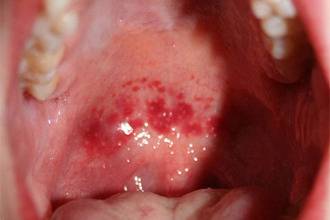
| angina | |
| scarlet fever | |
| streptococcal pharyngitis | |
| sinusitis | |
| phlegmonous laryngitis |
Rare diseases
Allergy
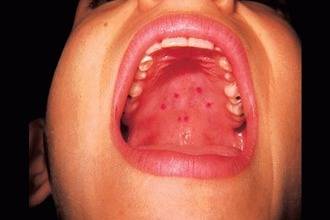
Other reasons
Usually, at a doctor’s appointment, a specialist examines the throat, even in cases where the patient does not complain. This procedure is necessary because some diseases of the throat can occur without any complaints from the ailing person.
Most often, a rash in the throat is detected by a doctor. Sometimes even a very attentive mother can notice some kind of rash when examining the throat of her child.
Rash in the throat
In some cases, the rash is accompanied by fever, runny nose, soreness, a feeling of crumbs stuck in the throat. Very often, children do not even complain of such symptoms. But this condition requires treatment, because it indicates the presence of infection.
The reasons

Viral diseases
What can cause red spots in the oropharynx? Theoretically, the cause of the pathological symptom can be any respiratory disease in which the infection is localized in the throat. Viral diseases are extremely rarely limited to damage to the laryngopharyngeal mucosa, so patients often complain of inflammation of the nasal mucosa and rhinitis.
Among the most common diseases in adults that cause a rash in the throat are:
| flu | high fever, chills, headaches, dry mouth, erythematous rashes on the throat, difficulty in nasal breathing, muscle weakness |
| herpangina | febrile fever, vesicular eruptions in the oropharynx, abdominal pain, difficulty swallowing, hypersalivation, fibrous film on the mucous throat |
| herpetic stomatitis | red throat, petechial rashes on the mucous membrane, burning and sore throat, aphthous formations in the mouth, swollen lymph nodes, painful swallowing |
| measles | high temperature, hoarse voice, large red spots on the soft and hard palate, red eye conjunctiva, sneezing and photophobia |
| rubella | macular rash on the body, headaches, inflammation of the throat mucosa, red spots on the palatine arches and the back of the throat, cervical adenopathy |
| infectious mononucleosis | fever, throat inflammation, swollen lymph nodes, pain when swallowing, red oropharyngeal rash, weakness, migraine, high fever |
| pharyngitis virus | perspiration in the laryngopharynx, dry cough, low-grade fever, shortness of breath, small vesicles on the palatine arches and the back of the throat |
It is possible to reliably determine the cause of the erythematous rash only after taking a throat swab for virological and microbiological analysis.
If the mucosa of the hypopharynx is covered with white dots, it is likely that a yeast-like or mold fungus has become a provocateur of inflammatory processes in the ENT organs ( candidal tonsillitis). Late treatment of diseases leads to the spread of infection and damage to the lower parts of the respiratory system, which is fraught with the development of bronchitis, laryngotracheitis, pneumonia, etc.
Bacterial diseases
 Red rash in the throat in an adult can be a consequence of the development of bacterial infections. As a rule, ENT diseases triggered by the development of microbes cause strong intoxication of the body. Therefore, delayed access to a doctor often becomes the cause of local or even systemic complications.
Red rash in the throat in an adult can be a consequence of the development of bacterial infections. As a rule, ENT diseases triggered by the development of microbes cause strong intoxication of the body. Therefore, delayed access to a doctor often becomes the cause of local or even systemic complications.
In chronic inflammation of the laryngopharyngeal mucosa, the clinical manifestations of the disease are mild, but as a result of poisoning the body with bacterial metabolites, the development of pyelonephritis, glomerulonephritis and cardiovascular insufficiency is not excluded.
Erythematous points and small vesicles in the throat may indicate the development of such pathologies:
| angina | pain on swallowing, hyperemia of laryngopharyngeal mucosa, hypertrophy of palatine tonsils, red rash in throat, ulceration of mucous membranes |
| scarlet fever | fever, malaise, petechial rash on the tongue and soft palate, the granularity of the posterior pharyngeal wall, peeling of the skin |
| streptococcal pharyngitis | non-productive cough, pharyngeal tickling, dry laryngopharyngeal mucosa, enlarged submandibular lymph nodes, fever, erythematous points in the pharynx |
| sinusitis | nasal congestion, headaches, general weakness, sore throat, red spots in the laryngopharyngeal mucosa |
| phlegmonous laryngitis | high fever, increased regional lymph nodes, red vesicles in the throat and larynx, symptoms of intoxication |
Important! Late treatment of bacterial infections leads to the development of abscess and hypoxia.
Active development of bacteria in the lesions leads to the formation of purulent masses in the bubbles on the mucous laryngopharynx. Over time, vesicles filled with clear exudate, replaced by ulcers. If you do not stop inflammation in time, it can lead to the melting of soft tissues and the formation of abscesses.
Rare diseases
Red spots on the back of the throat can be a manifestation of rare but dangerous diseases. Timely passage of drug therapy can prevent the progression of the disease and the development of complications. Solid spots on the soft palate and throat in rare cases indicate the development of pathologies such as:
kaposi's sarcoma - hemorrhagic rashes on the mucous membranes of the ENT organs, triggered by the development of malignant tumors; with the development of pathology often affects the skin and lymph nodes; petechiae in the sky - erythematous rash in the throat, which most often occurs against the background of the development of infectious mononucleosis; pyogenic granuloma - erythematous dome-shaped nodules formed in the mucous membranes of the respiratory tract and on the skin; homogeneous red papules are prone to bleeding and dissection, which causes pain and burning.
If the red spot in the throat causes itching or burning, you should be examined by a doctor. In 95% of cases, the rash signals the development of simple diseases that are not life threatening. However, delayed treatment of a banal tonsillitis or pharyngitis can lead to the development of a pharyngeal or peritonsillar abscess, entailing stenosis of the throat and choking.
Allergy
 For some reason, can "pour" the throat? In the absence of hyperthermia and symptoms of intoxication, erythematous rash in the throat can signal an allergic reaction. Exogenous and endogenous stimuli can provoke the formation of red spots on the mucous laryngopharynx, such as:
For some reason, can "pour" the throat? In the absence of hyperthermia and symptoms of intoxication, erythematous rash in the throat can signal an allergic reaction. Exogenous and endogenous stimuli can provoke the formation of red spots on the mucous laryngopharynx, such as:
composite fillings; medication; toothpastes and rinses; Food; dentures and pins; polymer crowns.
Allergies can cause severe edema of the laryngopharyngeal mucosa and difficulty breathing.
If the larynx is strewn with punctate spots that do not cause discomfort, most likely, the reason for their appearance lies in an allergic reaction. Animal hair, household chemicals and flowering plants are typical allergens that cause irritation of the mucous membrane and, accordingly, the formation of small red dots on the walls of the throat. Alleviate the manifestations of allergy antihistamines systemic and local action. However, the pathological reaction can be completely eliminated only if the provoking factor is eliminated, i.e. allergen.
Other reasons
Rash in the throat, causing severe discomfort and pain, signal a change in the morphology of soft tissues in the localization of red spots. Erythematous spots, localized in the soft palate and tongue, in some cases occur due to the development of complex diseases:
staphylococcal infection; exudative erythema; Kawasaki syndrome; syphilis; roseola; typhoid fever; meningitis.
Since the list of possible pathologies is quite extensive, when red dots appear in the pharyngeal pharynx, a visit to the therapist cannot be postponed. The principles of treatment depend on the etiological factors of the development of the disease, localization of lesions and associated clinical manifestations. As a rule, antibacterial and antiviral drugs are used to eliminate infectious ENT diseases. Antipyretics, analgesics and antihistamines allow you to relieve and eliminate discomfort.
Before you assign effective treatmentThe specialist must determine the cause of the rash in the throat.
Viral infections
Often rashes result from viral infection. In this case, the doctor prescribes antiviral drugs. Different types rashes are considered to be frequent signs of bacterial, viral infection. Such rashes are in second place after allergies.
SARS and flu
The concept of SARS covers a large number of viral infections affecting the upper respiratory tract. If the doctor does not diagnose the main disease early term, it is possible to attach a secondary infection to it, which will significantly complicate the therapeutic course.
ARVI is characterized by the appearance of the following symptoms in the patient:
general weakness; runny nose; dry cough; tickle; malaise; sore throat.
Spread airborne. It is possible to get SARS when visiting child care centers (school, kindergartenmugs).
The disease is usually detected at later stages of development, because at the initial stage the child does not experience a rise in temperature, and the child may not express other complaints.
Herpangina
Herpangina sore throat is a consequence of the primary infection of the herpes simplex virus, which belongs to the first type of virus. The disease can be severe. When the pathology recurs, a herpetic rash may occur on the mucous membranes of the mouth and lips.
The herpes simplex virus usually gets sick in childhood. After penetration into the body, the throat is usually infected. The disease is manifested by a small rash in the throat; in adults, a rash often appears on the mucous lips. Not always primary infection is accompanied by a rash. It may be asymptomatic. In this case, the infection, after entering the body, is localized in the nerve ganglia, remaining in a passive state.
The herpes virus manifests blistering rash in children. The treatment should be carried out by an infectious disease doctor.
"Children's" infections (rubella, measles, chickenpox)
Children have easier rubella and chickenpox than measles, which we write about below. The first symptoms of the disease appear 14 to 21 days after the infection. It usually proceeds favorably. Complications occur only in pregnant women. Complications are deafness, heart defects, fetal growth retardation, anomalies of eye development.
Shows measles in children in the form of a rash on the body, face, increase lymph nodes.
Measles is triggered by paramyxovirus, it can occur in children who have not been vaccinated. The disease begins with nasal congestion, fever, lacrimation, redness of the eyes, cough. On the third day the rash covers the face, body, white dots appear on the gums. This disease may be complicated by sinusitis, otitis, pneumonia.
Viral pharyngitis
With pharyngitis, there is a dry cough, stabbing pain in the larynx, scratchy, dry throat, feeling of coma in the throat. The mucous membranes of the throat are inflamed, red, they appear bloom, pus.
Infectious mononucleosis
This disease is very common, especially in children. Usually, monocytic sore throat occurs in mild forms that are very difficult to diagnose. Mononucleosis virus affects the lymphoid tissue. The virus is present in the tissues of the spleen, liver, tonsils, lymph nodes.
The virus is transmitted by airborne droplets. Incubation period makes a week - a couple of months. This difference in incubation depends on the condition of the body. This disease may be accompanied by angina, inflammation of the tonsils, swelling of the adenoid tissue.
Experts have not yet established the reason for the appearance of a rash in mononucleosis. The rash disappears along with signs of a major illness.
Stomatitis
Stomatitis usually occurs after exposure to the mucous membrane of various factors:
burns of varying severity; Reception at the dentist; inflammation provoked by a denture; stomach problems; injury to the mucous edge of a decaying tooth.
Rashes in this disease are of different types:
catarrhal; aphthous; ulcers.
Treating a rash with stomatitis is usually antiseptic, anesthetic medicines.
How to treat herpes stomatitis:
Bacterial infections
A rash may also occur due to a lesion. bacterial infection. Usually, ENT diseases develop when microbes enter the body. At the same time there is a strong intoxication. In the absence of timely treatment, local, systemic complications can occur.
Angina
Angina often develops on the background of low immunity. Infection can occur through the air. This disease is also caused by streptococcal infection, a seasonal virus. Disease manifests itself in:
sore throat; general weakness; swollen lymph nodes; redness of the tonsils; the appearance of purulent plaque on the tonsils; elevated temperature.
How to recognize herpes sore throat, says Dr. Komarovsky:
Scarlet fever
significant temperature increase; angina; swollen lymph nodes; severe redness of the throat; rash on the dermis, mucous membranes.
Transmitted by airborne droplets. This disease is very contagious. If you find the first symptoms of the patient should be isolated. If scarlet fever is combined with Streptococcus A, a strong tonsillitis begins.
Streptococcal infections
This group includes diseases that provoke hemolytic streptococcus. This pathogenic bacterium is present in the throat of each person, but inflammation begins only when conditions are suitable for its development.
Sinusitis
Sinusitis is an infectious and inflammatory disease. sinuses. This pathology is often fixed in children. Most sinusitis provoked by allergies, an infection (ARI, ARVI).
The infection infects the mucous membrane of the nose, then spreads to the mucous membrane of the sinuses. Often there is an exacerbation of the disease on the background of adenoids, polyps, tonsillitis, caries, rhinitis.
The main symptoms are:
pus, mucus from the nose; strong headache; pain in the upper jaw.
Laryngitis
Laryngitis is represented by inflammation of the larynx, vocal cords. Among the main reasons we indicate:
Rare diseases
A rash in the throat in the form of red dots can also occur in rare, dangerous diseases:
petechiae in the sky; Kaposi's sarcoma; pyogenic granuloma.
Bad habits, the external environment
A rash in the throat can occur when exposed to external / internal factors:
hypothermia; dry air; vitamin deficiency; violation of the gastrointestinal tract; inhalation of chemicals (volatile); allergy; endocrine disorders; lowering the reactivity of the organism; infectious diseases; bad habits.
Harmful habits in adults often cause activation of streptococcal infection. These habits are primarily
Tobacco smoke irritates the mucous membrane, at which it becomes more susceptible to disease.
Also streptococcal infections develop in the presence of such factors:
immunodeficiency states; heartburn; chemotherapy; use of glucocorticosteroids for a long time.
Endocrine disorders
Some diseases are associated with endocrine disorders in which the mucous membrane of the mouth and lips changes. Changes in the oral cavity manifest themselves in disorder of the thyroid, parathyroid glands, diabetes mellitus, disorders of the pituitary gland, adrenal glands, sex glands. In addition to the rash, there is a burning sensation, swelling, decreased salivation, bleeding gums, etc.
Diagnostics
When a rash in the throat appears, an examination by a specialist (ENT) is necessary. Usually, a rash in certain diseases is very characteristic, a specialist can easily make a diagnosis. If necessary, he appoint an additional lab. diagnostics:
general urine analysis; total blood count; the release of beta-hemolytic streptococcus A.
In the photo a rash in the throat of different etiology

Treatment
Treatment specialist will appoint after establishing an accurate diagnosis. A rash that occurs in diseases of different etiologies should be treated according to different regimens. Of the medications, doctors prescribe antihistamines, painkillers, antivirals, antipyretics, immunomodulators, antibiotics, vitamins, anesthetics.
It is necessary to start treatment in time so as not to cause a complication. Facilities traditional medicine can be used as an adjunct to primary therapy. In any case, self-medication can cause deterioration of the patient's condition.
Recipes and Ways to Help
Red rash in the throat is usually accompanied by pain. You can use some folk remedies to relieve inflammation of the tonsils. To eliminate pain, swelling can be rinsed with the following means:
decoction of flax seeds; the extract of chamomile, lime, sage; calendula and rosehip oil; tea with mint, lime color; sea buckthorn oil.
How to pick the most effective rinsing for throat, see in our video:
What is dangerous condition
If you do not treat the disease that provoked a rash in the throat, complications can occur. So, in the absence of treatment of viral diseases, the infection can spread to the lower parts of the respiratory system (bronchitis, pneumonia, laryngotracheitis).
Chronic inflammation of the mucous membrane in the laryngeal pharynx can provoke the development of glomerulonephritis, pyelonephritis, cardiovascular insufficiency.
Without due
treating sore throats
Pharyngitis may develop a pharyngeal, paratonsillar abscess. Such abscesses can cause choking,
stenosis of the throat
Forecast
Usually the prognosis is favorable. The main thing in time to detect a rash, properly treat the disease that provoked it.
Prevention
Preventing a sore throat involves maintaining the child’s immune system. It is also necessary to ensure that the child is dressed according to weather conditions. A special role is given to the implementation of preventive vaccinations. With the spread of infection, during the period of epidemics, it is necessary to reduce the risk of infecting a child by restricting visits to public places.
Sometimes parents notice that the baby has red dots or spots in the sky. The same marks may occur in the mouth of an adult. How to determine the cause of the rash, and what to do to get rid of them? Consider the main factors contributing to the occurrence of rash and methods of treating such conditions.
Causes of red spots on the sky in a child and an adult
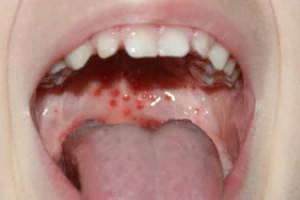 Mouth rash may be caused various factors. Red dots in the sky in a child can be the result of dental diseases, as well as diseases of organs and systems. To identify the source of the problem, it is necessary to carefully consider the appearance of the rash. The most likely causes of stains with explanations of their origin, you can learn from our material.
Mouth rash may be caused various factors. Red dots in the sky in a child can be the result of dental diseases, as well as diseases of organs and systems. To identify the source of the problem, it is necessary to carefully consider the appearance of the rash. The most likely causes of stains with explanations of their origin, you can learn from our material.
Fungal diseases of the oral cavity
The fungus often attacks people with low immunity. In the oral cavity, fungi of the genus Candida breed, which cause a disease such as stomatitis. In the mouth of a child or adult who has become a victim of thrush, you can see white bloomunder which inflammatory tissues are found. The photo shows that stomatitis can be localized on the tongue, mucous membrane of the cheeks and in the sky. In the latter case, small red sores and white dots may appear.
Stomatitis and other infections and viruses
Stomatitis, which causes enanthema (rash on mucous membranes), has a different nature. We have already talked about a fungal infection, so we will consider other pathogens:
Herpetic stomatitis occurs due to infection with the herpes virus. This form is characterized by the appearance of bubbles on the oral mucosa, filled with clear or turbid liquid. Painful education arise on the tongue, gums, inner lips and cheeks. This form of the disease is often accompanied by fever. 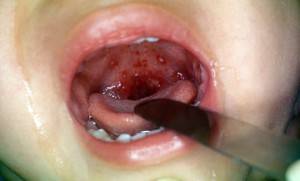 Chickenpox. Children get sick with chickenpox more often, getting immunity for the rest of their lives. The rash mainly covers the entire surface of the body, occasionally bubbles with liquid appear in the baby's mouth - on the tongue, cheeks. The disease can cause discomfort and fever, but sometimes it is almost asymptomatic, not counting the painful formations. ORVI. Occasionally, an infectious disease of the upper respiratory tract causes a rash in the mouth. Sore throat, tonsils can spread to the entire oral cavity. If the patient also suffers from rhinitis and breathes through the mouth, the tongue and the sky dry at night, the mucous becomes dry, cracked, red spots appear on it. Herpes or herpetic sore throat. Distinctive signs - vesicles filled with content white color. After a certain period of time, they burst, turning into red ulcers. Rash covers pharynx, tonsils, uvula and spreads further. Other symptoms of herpes sore throat are pain when swallowing, enlarged cervical lymph nodes. Bacterial infection. Herpes and SARS are related to viral diseases, but bacteria can also cause inflammation of the oral mucosa. Often, pathogens such as staphylococcus and streptococcus become the source of a rash in the sky. The latter is quite dangerous because it causes late complications. A staph infection can give rise to tonsillitis, pharyngitis or tracheitis. Red dots on the tongue, palate and cheeks are more likely a sign of tonsillitis.
Chickenpox. Children get sick with chickenpox more often, getting immunity for the rest of their lives. The rash mainly covers the entire surface of the body, occasionally bubbles with liquid appear in the baby's mouth - on the tongue, cheeks. The disease can cause discomfort and fever, but sometimes it is almost asymptomatic, not counting the painful formations. ORVI. Occasionally, an infectious disease of the upper respiratory tract causes a rash in the mouth. Sore throat, tonsils can spread to the entire oral cavity. If the patient also suffers from rhinitis and breathes through the mouth, the tongue and the sky dry at night, the mucous becomes dry, cracked, red spots appear on it. Herpes or herpetic sore throat. Distinctive signs - vesicles filled with content white color. After a certain period of time, they burst, turning into red ulcers. Rash covers pharynx, tonsils, uvula and spreads further. Other symptoms of herpes sore throat are pain when swallowing, enlarged cervical lymph nodes. Bacterial infection. Herpes and SARS are related to viral diseases, but bacteria can also cause inflammation of the oral mucosa. Often, pathogens such as staphylococcus and streptococcus become the source of a rash in the sky. The latter is quite dangerous because it causes late complications. A staph infection can give rise to tonsillitis, pharyngitis or tracheitis. Red dots on the tongue, palate and cheeks are more likely a sign of tonsillitis.
Blood vessel pathologies
In people suffering from cardiovascular diseases, it is possible to change the color and condition of the oral mucosa. Obvious manifestations of changes in vascular permeability - the appearance of red spots, cyanosis of the lips, tongue, or atypical pallor of the gums. In addition, there may be bubbles in a dense shell with transparent contents at the top of the soft sky, the inner surface of the cheeks. This syndrome is called blistering and is described in 1972 by a group of scientists led by Mashkillleason. Most patients associated the appearance of blisters in the mouth with an increase in blood pressure. In this regard, it is sometimes recommended that patients at the dentist visit a cardiologist to rule out heart and vascular disease.
Allergic reactions
Allergies to any product can be expressed not only in spots on the cheeks, skin rashes. Rashes can appear on the oral mucosa. However, it is not always easy to determine this - the allergen imperceptibly accumulates in the body and manifests itself in the form of a small rash far from immediately. By removing a product that causes a symptom from the diet, an improvement is expected after a week or two. If there is a suspicion that this is an allergy, it is worth examining other places where it may appear - cheeks, wrists, elbows, armpits, genitals.
If you find concomitant skin manifestations, it is best to consult an allergist. A specialist will prescribe a study (allergy testing) and help identify the source of the problem.
Other reasons
A rash in the sky can be caused by other reasons, which in practice are much less common than the above. It is necessary to have an idea about them, so as not to miss the typical symptoms:
Tuberculosis. The disease affects not only the lungs, but also other organs. The disease can overtake the child and the adult, who for some reason have weakened the body's defenses. Tuberculosis of the mucous membranes of the oral cavity is expressed in the appearance of tiny flat dots with a red or yellowish-red hue. Over time, they merge to form plaques with a non-uniform surface. Vitaminosis. This condition can rarely cause a rash inside the cheeks and lips or the development of fungal diseases. Oncological diseases of the oral cavity. Such a diagnosis sounds infrequently, but you should learn about the first symptoms of mucosal cancer. As a rule, with this disease in the sky there is a sore, which tends to increase. At first, it does not hurt and does not bother, but over time it becomes an obstacle during the meal, swallowing.
Related symptoms
In previous sections we talked about related symptoms various diseases that could lead to a rash. Depending on the cause, red dots in the sky can be accompanied by:
 fever, increased cervical lymph nodes, pain when swallowing saliva, eating food, rash can be localized not only on the palate, but also on the lips, tongue, inner surface of the cheek, as well as on the body; specks can transform - grow, turn into sores or papules .
fever, increased cervical lymph nodes, pain when swallowing saliva, eating food, rash can be localized not only on the palate, but also on the lips, tongue, inner surface of the cheek, as well as on the body; specks can transform - grow, turn into sores or papules .
Diagnostic methods
The specialist will be able to make an accurate diagnosis, focusing on the visible symptoms, a list of patient complaints, research results. If you find a rash in the sky, you should contact your dentist or general practitioner. The first will determine whether this symptom is related to oral diseases, the second will refer to narrow specialists: an allergist, a gastroenterologist, a phthisiologist, or an ENT specialist. Possible examinations - a pharyngeal smear for baccosis, a blood test, allergy tests, feces analysis for dysbacteriosis.
When do I need to see a doctor?
If specks in the mouth appeared in a child, it is worth going to the doctor immediately. This is especially true for kids up to a year. In adults, a rash in the mouth also requires attention, because its appearance may indicate the presence of pathologies.
Consider the symptoms, in the presence of which you should not cancel the visit to the doctor:
pain in the throat when swallowing, extending to the ear, teeth; the rash is transformed, changes color, size and texture, fever, lymph nodes in the neck and throat, growth of mucosal lesions.
Features of the treatment of red spots on the mucous
Depending on the diagnosis, the doctor prescribes treatment. When bacterial lesions of the oral cavity are prescribed antibiotics, for the treatment of herpes - antivirals. If a fungus is diagnosed, antifungal drugs are used.
The doctor prescribes and local treatment - gels and ointments that promote the healing of ulcers and the removal of pain. Such drugs give a good effect:
Miramistin; 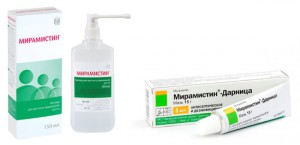 kamistad gel; Holisal; Metrogil Dent; Solcoseryl.
kamistad gel; Holisal; Metrogil Dent; Solcoseryl.
Folk remedies
To cope with the problem will help folk remedies. It should be understood that treatment without diagnosis can aggravate the condition, therefore, it is desirable to use such therapy only as an auxiliary one. Antiseptic rinses will help to get rid of stains:
to ½ tsp soda and salt, 5 drops of iodine per cup of boiled water; 2 tbsp. l chamomile flowers pour 200 ml of boiling water and insist on a water bath for 40 minutes, then strain and dilute with water to the original volume; propolis tincture diluted with water in a ratio of 1:20; hydrogen peroxide - 1 tsp. in a glass of water.
Preventing mouth rash
Most often, the rash on the mucous membranes are the result of infection. In this regard, for the prevention of the appearance of spots and pimples on the mucous membrane, it is desirable to observe hygiene and in time seek help from a specialist. It is important to monitor your diet - a balanced diet and the presence of vitamins and minerals in food will help to avoid beriberi and associated problems.
Popular
- Breast cancer is curable at any stage.
- The remedy for the cold Sinupret
- Azitrox - official instructions for use
- Chicken-bjaka: allowed antibiotics were found in Russian chicken
- Oral Cancer: Symptoms and Treatment
- Dark and thick blood during menstruation.
- Modern analogues of doxycycline tablets
- Is it possible to die from pneumonia
- What earwax will tell all about your health
- Tussin: instructions for use



